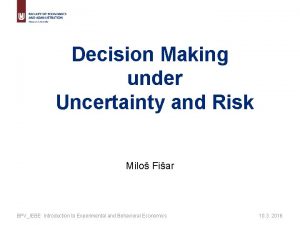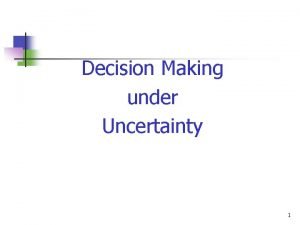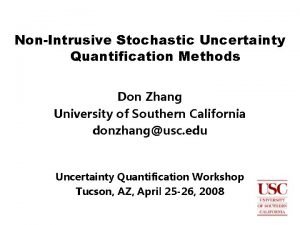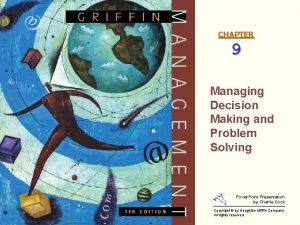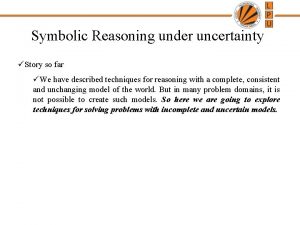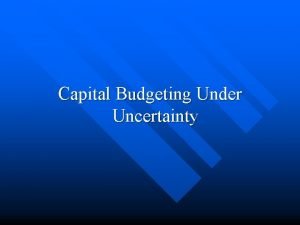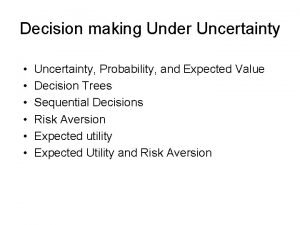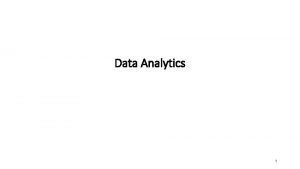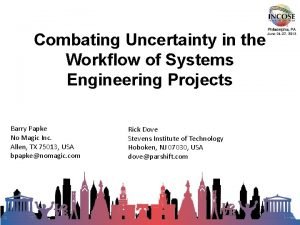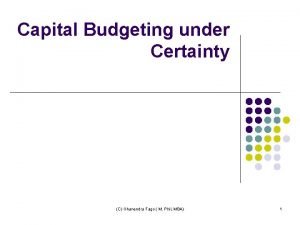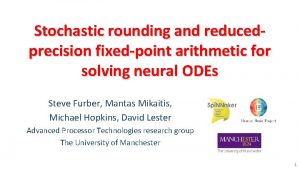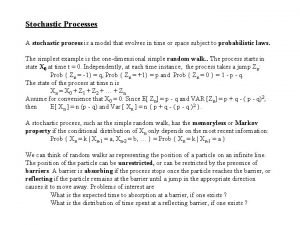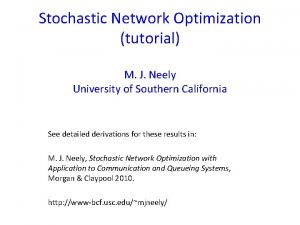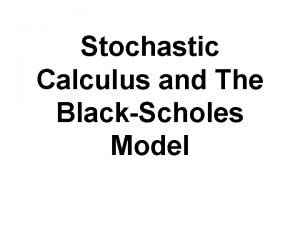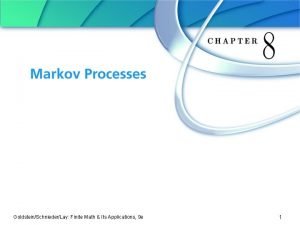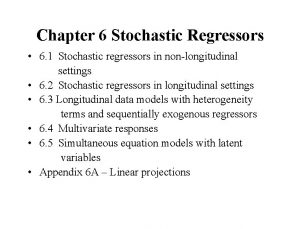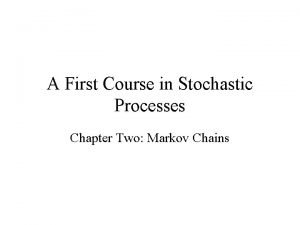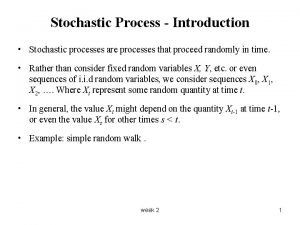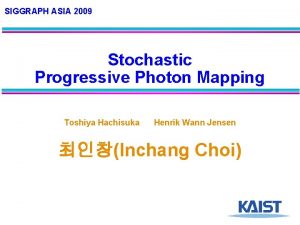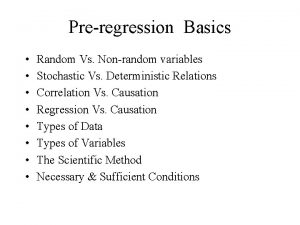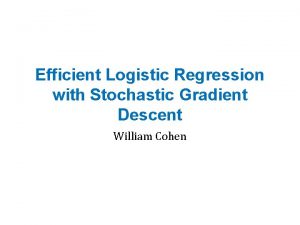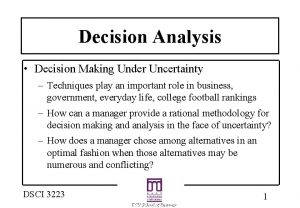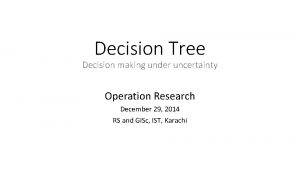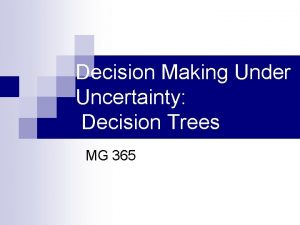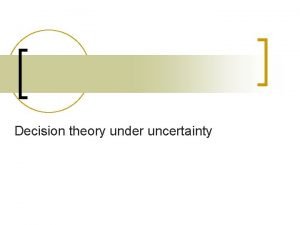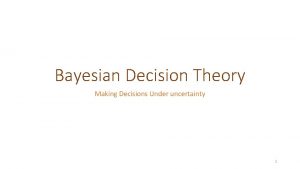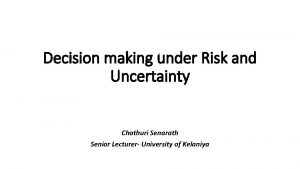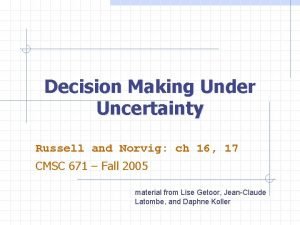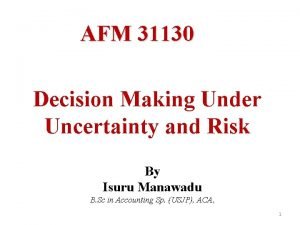Decision making under uncertainty Stochastic methods in Engineering




























- Slides: 28

Decision making under uncertainty Stochastic methods in Engineering Risto Lahdelma Professor, Energy for communities

Content • • • What is uncertainty Stochastic dominance Utility theory Risk attitude Multi-criteria decision analysis Multicriteria utility function

What is uncertainty ”I used to be uncertain, but now I am not sure” • Uncertainty can mean different things – – Inaccurate: his height is 190 cm Imprecise: his height is in range [185, 195] Fuzzy (vague): he is tall Classical probability: tossing heads on a fair coin has 50% probability – Subjective probability: I believe there is 50% chance for rain tomorrow – Statistical probability: I win my friend in Badminton 6 times out of 10

Representing uncertainty • Many ways – Standard uncertainty, confidence margins, fuzzy sets, rough sets, … • Different kinds of uncertainty can be represented using probability distributions – In most cases this is an approximation of reality – Almost nothing is certain – not even the probability distribution to represent uncertainty – Still we must represent uncertainty the best we can and consider it in decision making

Biases in estimating uncertainty • People cannot assess probabilities well – After tossing 6 heads on a coin, what is more likely next, heads of tails? – When tossing a coin, which sequence is more likely, HHHTTT or HTHTHT ? – You see a good looking woman in a bar. Is she more likely a model or nurse? – Is it more likely that an English word starts with K or that K is the third letter? – Is the percentage of African countries in UN greater or less than xx%? How large?

Biases in estimating uncertainty – Which is more likely, getting 7 figures right on Lotto or dying in car accident while submitting Lotto coupon? – If the probability of rain is 50% on Saturday and 50% on Sunday, what is the probability that it will rain during weekend? – Which number series has greater variance: A: 6 B: 1110 18 1122 4 1108 5 1109 17 1121 – Which is more likely: A: That Williams loses the first set in Tennis. B: That Williams loses the first set but wins the match. – Estimate 90% confidence margin for the distance to the second brightest star Canopus (in light years).

Decision under uncertainty • Many different approaches to compare uncertain alternatives – Single criterion decision making • Typically, money is the criterion • Different aspects of the decision alternatives are expressed in monetary units – Multiple criterion decision making • Multiple non-commensurate criteria (objectives) must be considered simultaneously

Stochastic dominance • You have to choose between a 1, a 2, a 3 with outcomes at probabilities 1, 2, 3 • Such dominating alternative does not often exist

Maximin / pessimistic criterion • Choose alternative with best worst case • Often this is too extreme, in particular if the probability for the worst case is very small

Maximax / optimistic criterion • Choose alternative with best case • Also this is may be unwise

Expected value • Choose best expected value • Commonly used • People do not often behave like this

Gamble situation • Which alternative do you prefer? A) 10 000 € for sure B) 20 000 € for p=0. 6 but 0 for p=0. 4 – Expected value of B is 12 000

Gamble situation • Which alternative do you prefer? A) 10 000 € for sure B) 20 000 € for p=0. 6 but 0 for p=0. 4 – Expected value of B is 12 000 • Many people choose A • This behaviour is called risk aversion – A certain outcome is preferred to a risky choice with a little higher expected value

Utility theory • Preferences in the precence of risk can be modelled using a utility function u(x) • The u(x) is a monotonic function that maps the worst outcome to 0 and the best outcome to 1 • The decision maker (DM) maximises the expected utility E(u(x))

Expected utility • For discrete case x = <p 1, x 1 ; . . . pn, xn > E(u(x)) = i piu(xi) • For continuous case x with density f(x) E(u(x)) = x f (x)u(x)dx

Risk averse DM • Risk averse DM prefers certain outcome to gamble with (little) higher expected value – A rational DM is normally assumed to be risk averse or risk neutral – Opposite of risk averse is risk-seeking, who prefers a gamble

Concave utility function • Risk averse behaviour corresponds to utility function with decreasing marginal u(x) utility, i. e. concave shape 1 0. 9 0. 8 0. 7 0. 6 0. 5 0. 4 0. 3 0. 2 0. 1 • Concavity 0 -30 -20 -10 0 10 20 30 p 1 u(x 1)+(1 -p 1)u(x 2) <= u(p 1 x 1+(1 -p 1)x 2) 40 50 60 70 80 90

Shape of utility function Linear=Risk-neutral Concave=Risk-averse Convex = Risk-seeking

Example • To drill or not drill for oil A) Cost of drilling is 20, chance of finding is 25%, profit in this case is 80 B) Don’t drill, no cost, no profit – Utility function u(x) = (20+x)0. 5/10 u(A) = (0. 25*10+0. 75*0)/10 = 0. 25 u(B) = ( 20)/10 0. 447 • Don’t drill. – (using expected values, E(A)=5, E(B)=0)

Multicriteria decision making • Choosing most preferred alternative considering multiple non-commensurate criteria – If all criteria can be made commensurate, expressed e. g. in money, then the problem reduces into single criterion – Sometimes this is not possible or desired to do that – Some criteria are really difficult to combine

Non-commensurate criteria • Examples – – Cost, quality, reliability Economy, environment, human health Effects on different interest groups Energy efficiency, emissions, service level

Multicriteria utility function • Utility is a function with multiple arguments u(x 1, x 2, …, xn) – – Cost, quality, reliability Economy, environment, human health Effects on different interest groups Energy efficiency, emissions, service level

Multicriteria utility function – 2 -criterion example • The City is considering four sites (A, B, C and D) for a new power plant • The objectives of the city are to – minimise the cost of building the station; – minimise the area of land damaged by building it. • Factors influencing the objectives include – the land type at the different sites, – the architect and construction company hired, – cost of material and machines used, the weather, etc.

Multicriteria utility function – 2 -criterion example • Criteria evaluation – Costs, are estimated to fall between 15 M€ and 60 M€ – between 200 and 600 hectars of land will be damaged • The possible consequences of the decision alternatives are captured by two criteria. • We need to determine a two-attribute utility function: u(Cost, Area) or u(C, A)

Multicriteria utility function assessment • Let x 1, . . . , xn, n ≥ 2, be a set of criteria associated with the consequences of a decision problem. • The utility of a consequence (x 1, . . . , xn) can be determined from direct assessment: – estimate the overall utility u(x 1, . . . , xn) over the given values of all n attributes; • Decomposed assessment: – estimate n partial utilities ui(xi) for given values of the n criteria; – Define u(x 1, . . . , xn) as combination of ui(xi) for all criteria: u(x 1, …, xn) = u(u 1(x 1), …, un(xn))

Decomposed assessment • Decomposed assessment is commonly used especially when there are many criteria – The additive form is often used • u(x 1, …, xn) = u(u 1(x 1), …, un(xn)) = w 1 u 1(x 1)+…+wnun(xn) – Here w 1, …wn are importance weights given for the criteria – Weights are subjective information that should be obtained from the DMs • If the partial utility functions are linear, then the overall utility function is linear (risk neutral behaviour) – Concave partial utility functions means risk averse behaviour

Decomposed assessment • The City models the utility as additive function. • The partial utility functions u. C and u. A are assessed u. C(15) = 1; u. C(30) = 0. 5; u. C(50) = 0. 2; u. C(60) = 0 u. A(200) = 1; u. A(300) = 0. 8; u. A(400) = 0. 5; u. A(600) = 0 • Cost is considered three times as important as Area. • Utilities for various Cost, Area pairs are then computed: – – – u(50, 300) = 3 · u. C(50) + 1 · u. A(300) = 3 · 0. 2 + 1 · 0. 8 = 1. 4 u(30, 400) = 1. 5 + 0. 5 = 2. 0 u(60, 200) = 0. 0 + 1. 0 = 1. 0 u(15, 600) = 3. 0 + 0. 0 = 3. 0 u(15, 200) = 3. 0 + 1. 0 = 4. 0

Excercise • Choose (Cost, Area) values for the four alternatives A, B, C, D • For Cost, let each alternative have two possible values with different probabilities • Compute the expected utility for the alternatives
 Uncertainity in decision making
Uncertainity in decision making Decision-making under uncertainty
Decision-making under uncertainty Stochastic uncertainty
Stochastic uncertainty Decision making under bounded rationality
Decision making under bounded rationality Objectives of decision making
Objectives of decision making Slidetodoc.com
Slidetodoc.com Reiters
Reiters Capital budgeting under uncertainty
Capital budgeting under uncertainty Expected profit under uncertainty
Expected profit under uncertainty Which decision model incorporates the uncertainty element
Which decision model incorporates the uncertainty element Systems engineering with uncertainty
Systems engineering with uncertainty Investment decision under certainty
Investment decision under certainty Metal coping fpd
Metal coping fpd Stochastic rounding
Stochastic rounding Stochastic programming
Stochastic programming Stochastic process model
Stochastic process model Divbar
Divbar Deterministic demand vs stochastic demand
Deterministic demand vs stochastic demand Put call formula
Put call formula Stochastic vs dynamic
Stochastic vs dynamic Absorbing stochastic matrix
Absorbing stochastic matrix Regressors meaning
Regressors meaning Non stochastic theory of aging
Non stochastic theory of aging A first course in stochastic processes
A first course in stochastic processes Stochastic process introduction
Stochastic process introduction Stochastic progressive photon mapping
Stochastic progressive photon mapping Known vs unknown environment
Known vs unknown environment Non stochastic variable
Non stochastic variable Logistic regression stochastic gradient descent
Logistic regression stochastic gradient descent
